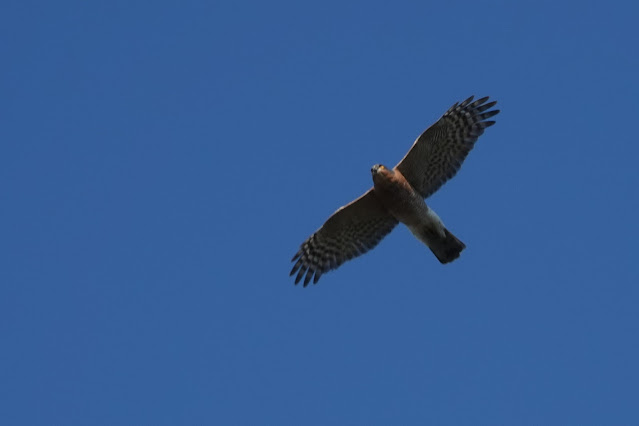I had a talk booked yesterday evening for the Faversham Natural History Group so I pottered east out of the Medway fog bank before lunchtime and made my way toward Tankerton for a look for the Pallas’s Warbler that had been around since before Christmas. It was all blue skies and sunshine when I arrived by the colourful beach huts and the fog was only lingering offshore clouding the turbines from view.
A chance encounter with Andy Taylor as I got out of the car
led to a good catch up about all things ornithology whilst the Brents grumbled
along the tide line where countless bounding hounds chased the gulls, Curlews
and Oystercatchers from their lunch.
After some tips from Andy I ambled east and down along The
Brook and although I did not find the elusive little sprite it was very
pleasant and spring like and given the attire of some of the locals I was
somewhat overdressed.
A Cetti’s Warbler was giving it large from the streamside
Brambles and Robins, Wrens, Dunnocks and three Tit species were feeding in the
still bare Elms, Willows and Aspen. A
male Sparrowhawk put on a grand display overhead and attracted a female who
powered in with exaggerated wing beats to join him. A couple of Grey wagtails
flew over towards the sewage works and a very smart Brown Rat was investigating
the margins before sitting up under a Bramble to wash her face and hands. I even checked some Burdock heads to see if I
could find the cocooned larvae of Mertzneria lappella and was pleasantly
surprised that I could!
 |
| Sparrowhawk |
.JPG) |
| Mertzneria lappella moth pupa in Burdock seedheads |
.JPG) |
| Mertzneria lappella moth pupa in Burdock seedheads |
I ambled back and sat on a bench with my coffee and watched
the now closer waders on the incoming tide that included scurrying mice-like
silver Sanderlings while a Great Northern Diver was snorkelling some way out.
From here I wiggled down to Grove Ferry where I was greeted
by singing Song and Mistle Thrushes around the car park. It was still surprisingly balmy as I headed out
and my short walk soon became a long one out to the tower hide on the Lampen
Wall.
I did not see a huge variety of species but it was a magical
early evening of golden light, no wind and memorable views. Cetti’s Warblers
were vocal and I heard a couple of Water Pipits on one of the floods and a
Stonechat kept watch from the top of a reedbed bush. Bizarrely I only saw one Marsh Harrier
although it was a fine tricoloured male.
 |
| Teal |
I cut through to the banks of the Great Stour (passing a ballet
dancer photoshoot on the way…) and almost immediately saw a Kingfisher darting
ahead of me. The river was oozing along slowly and looks so different in the winter. I was hoping (as ever) to see a Beaver but
once again they eluded me although there were plenty of signs that they are not
hibernating with freshly stropped bark
and chewed stumps and five muddy slipways between the Stour and the marsh. You could see where they had pulled
themselves up and slid down and at the top you could see claw marks and even
the impression from that amazing tail. Perhaps this will be the summer I get to
see them? Natural England (I presume)
had put stakes either side of the mouth of each slide to stop people following
suit!
 |
| Beaver tail marks |
 |
| Beaver slide |
 |
| Beaver slide |
A herd of Belted Galloways were feeding out in the marsh and Lapwings circled into the meadows near the middle hide displacing a Green Sandpiper in the process. A Kingfisher once again flew on ahead and Goldcrests and Long-tailed Tits were moving through the Willows while I could hear but not see Bullfinches.
 |
| Belted Galloways |
A large female Marsh Frog was found sitting in the middle of the path looking a little bewildered so I helped her to the ditch in the direction she was facing.
 |
| Marsh Frog |
As I neared the hide I could hear the rumbling of the Cormorants in the dead trees out on the lake and hundreds more were arriving in ragged phalanxes from both the Reculver and Sandwich coasts. I could not find the Ring-necked Duck from up top and did not fancy pushing on to the Reedbed Hide where I would have found even more challenging light conditions. I did however find a Ceroxys urticae Picture Wing Fly in the hide. The view back the way I had come was bathed in late afternoon sun and I stood for a while and scanned for Bitterns and such like.
 |
| Cormorants |
 |
| Cormorants |
 |
| Ceroxys urticae |
Fieldfares were ‘chacking’ all around and many seemed to be descending into the dense Willow swamp alongside the path which was decked out in festoons of lichen where a wall of soft sub-singing quickly built up. I turned around and began the walk back with the sun now behind me. It was so tranquil and there was no one around – just me and the sounds of a winter marsh winding down for the day.











No comments:
Post a Comment